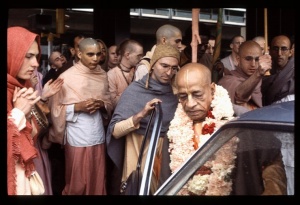CC Antya 3.100 (1975)

A.C. Bhaktivedanta Swami Prabhupada
Below is the 1996 edition text, ready to be substituted with the 1975 one using the compile form.
TEXT 100
- nirjana-vane kuṭira kari’ tulasī sevana
- rātri-dine tina lakṣa nāma-saṅkīrtana
SYNONYMS
nirjana-vane—in a solitary forest; kuṭira—a cottage; kari’—making; tulasī—the tulasī plant; sevana—worshiping; rātri-dine—throughout the entire day and night; tina—three; lakṣa—hundred thousand; nāma-saṅkīrtana—chanting of the holy name.
TRANSLATION
Haridāsa Ṭhākura constructed a cottage in a solitary forest. There he planted a tulasī plant, and in front of the tulasī he would chant the holy name of the Lord 300,000 times daily. He chanted throughout the entire day and night.
PURPORT
The village of Benāpola is situated in the district of Yaśohara (Jessore), which is now in Bangladesh. Benāpola is near the Banagāṅo station, which is at the border of Bangladesh and may be reached by the Eastern Railway from Sealdah Station in Calcutta. Haridāsa Ṭhākura, being the ācārya of chanting the Hare Kṛṣṇa mahā-mantra, is called Nāmācārya Haridāsa Ṭhākura. From his personal example we can understand that chanting the Hare Kṛṣṇa mantra and becoming highly elevated in Kṛṣṇa consciousness is very simple. Without difficulty one can sit down anywhere, especially on the bank of the Ganges, Yamunā or any other sacred river, devise a sitting place or cottage, plant a tulasī tree, and before the tulasī chant the Hare Kṛṣṇa mahā-mantra undisturbed.
Haridāsa Ṭhākura used to chant the holy name on his beads 300,000 times daily. Throughout the entire day and night, he would chant the sixteen names of the Hare Kṛṣṇa mahā-mantra. One should not, however, imitate Haridāsa Ṭhākura, for no one else can chant the holy name 300,000 times a day. Such chanting is for the mukta-puruṣa, or liberated soul. We can follow his example, however, by chanting sixteen rounds of the Hare Kṛṣṇa mahā-mantra on beads every day and offering respect to the tulasī plant. This is not at all difficult for anyone, and the process of chanting the Hare Kṛṣṇa mahā-mantra with a vow before the tulasī plant has such great spiritual potency that simply by doing this one can become spiritually strong. Therefore we request the members of the Hare Kṛṣṇa movement to follow Haridāsa Ṭhākura’s example rigidly. Chanting sixteen rounds does not take much time, nor is offering respects to the tulasī plant difficult. The process has immense spiritual potency. One should not miss this opportunity.